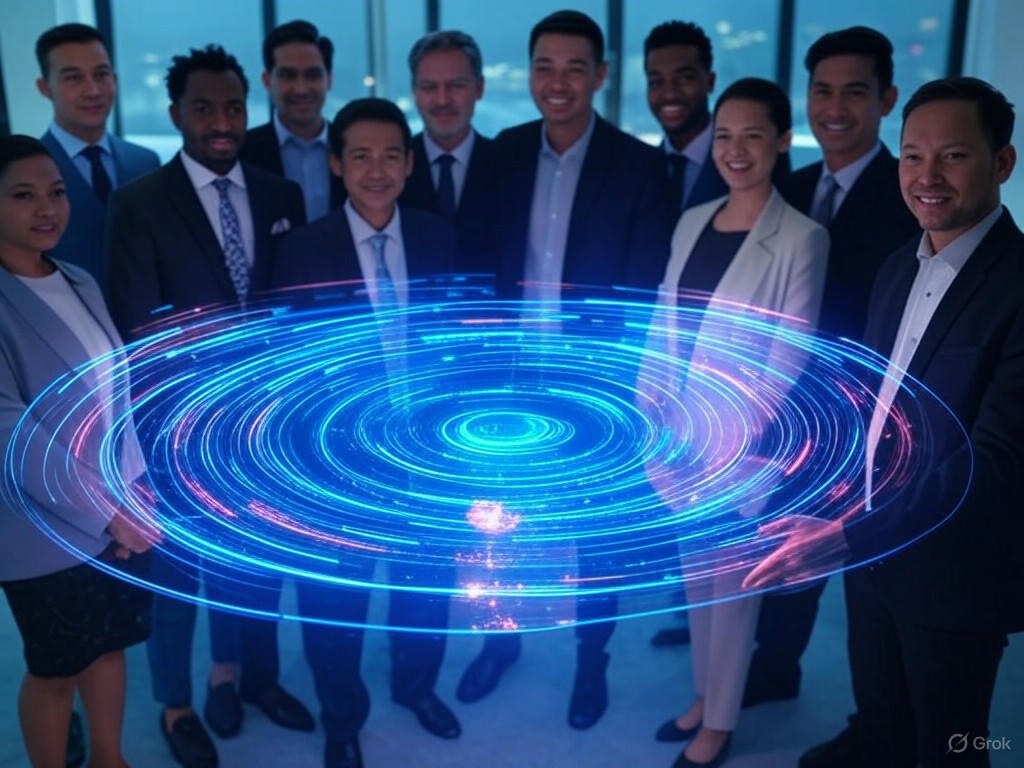
AI Workplace Inequality: Expert Strategies to Combat It
The Evolving Landscape of AI in the Workplace
AI workplace inequality is becoming a defining issue as we push into 2025, with artificial intelligence transforming how we work in profound ways. More than 72% of businesses have already integrated AI into at least one function, yet only 11% of employees engage with it weekly. This gap isn’t just a tech hiccup; it’s creating divides that could widen if we don’t act smartly.
Think about it: projections warn that up to 300 million jobs might be disrupted by AI, and nearly a third of workers are already anxious about being replaced. That means AI workplace inequality isn’t just theoretical—it’s a real threat that could leave some groups behind while others surge ahead. But here’s the silver lining: we can turn these challenges into opportunities by focusing on inclusive strategies that benefit everyone.
Ever wondered how AI could actually bridge gaps instead of widening them? By addressing these disparities head-on, organizations can build a more equitable future where technology empowers all employees.
The Current State of AI Workplace Inequality
This form of inequality shows up in biased algorithms, limited access to tools, and uneven training opportunities. Let’s break it down with some eye-opening stats that highlight just how pervasive AI workplace inequality has become.
Disparate Impact Across Demographics in AI Workplace Inequality
Younger workers, especially those aged 18-24, are 129% more likely to fear job obsolescence from AI compared to seniors over 65. There’s also a gender divide: 44% of men are prioritizing AI skills, while only 36% of women are. These patterns underscore how AI workplace inequality can hit certain groups harder, amplifying existing societal imbalances.
It’s not just about age or gender, either—geographic factors play a big role. In advanced economies, 60% of jobs could be at risk, versus just 26% in low-income countries. This uneven exposure makes tackling AI workplace inequality a global priority, one that demands targeted solutions to ensure no one gets left in the dust.
The AI Skills Gap and Its Role in Workplace Inequality
Access to AI training is uneven, with 40% of global talent now prioritizing these skills—up from 29% recently. Yet, many employees still lack the resources to catch up. The gender gap in AI roles persists, with women making up only 29.4% of AI engineers by 2025, up from 23.5% in 2018.
What does this mean for your team? If left unaddressed, the skills gap could deepen AI workplace inequality, turning it into a barrier for career growth. Imagine a workplace where everyone has the tools to thrive—it’s possible with the right investments.
Key Challenges in Achieving Equality Amid AI Workplace Issues
Fighting AI workplace inequality means confronting several core obstacles. From biased systems to adoption gaps, these challenges require thoughtful, proactive responses.
Algorithmic Bias and Its Contribution to Workplace Inequality
AI doesn’t start from scratch; it often inherits and magnifies human biases, especially in hiring and evaluations. For instance, resume-screening tools might favor certain demographics, perpetuating discrimination. The EEOC urges employers to test AI tools regularly to avoid legal pitfalls and ensure fairness.
This bias doesn’t stop at recruitment—it can influence daily tasks, like project assignments. Picture a scenario where AI recommendations lead managers to overlook talented employees based on subtle prejudices; that’s exactly what we’re up against in AI workplace inequality. To counter this, companies must prioritize oversight and ethical design.
Leadership-Employee AI Adoption Gap
While 80% of C-suite executives see AI as a driver of innovation, few frontline workers are actually using it. This mismatch creates a tiered workplace where benefits flow unevenly. Looking ahead, 20% of leaders expect generative AI to handle over 30% of daily tasks soon, but without broad access, this could exacerbate AI workplace inequality.
Have you noticed this divide in your own organization? Bridging it is key to making AI a tool for all, not just the privileged few. By democratizing technology, we can turn potential risks into shared advantages.
Expert Strategies to Tackle AI Workplace Inequality
Overcoming AI workplace inequality demands a comprehensive plan, blending policies, tech safeguards, and cultural shifts. Here’s how experts recommend getting started.
Implementing Robust AI Governance to Fight Workplace Inequality
Start with strong governance frameworks that promote ethical AI use. Regular bias audits are essential—think of New York City’s law that requires testing automated tools before deployment. These steps help catch problems early and build trust.
Clear policies in employee handbooks can outline AI usage, training needs, and ways to report issues. Plus, establishing accountability ensures someone is always on the hook for fixing problems. Actionable tip: Schedule audits every six months to keep your AI systems aligned with equality goals.
- Regular Bias Audits: Test AI tools thoroughly and often.
- Clear AI Policies: Define rules for use and training.
- Accountability Mechanisms: Assign responsibility for outcomes.
Democratizing AI Skills to Address Workplace Inequality
Everyone should have access to AI training, not just tech experts. Universal programs can level the playing field, while targeted upskilling helps underrepresented groups catch up. Mentoring initiatives pair experienced staff with newcomers, fostering a culture of shared knowledge.
Here’s a real-world example: A company that rolled out company-wide AI workshops saw engagement soar and reduced turnover. By making these resources available, you’re not just fighting AI workplace inequality—you’re investing in your team’s future.
- Universal AI Training: Offer programs for all levels.
- Targeted Upskilling: Focus on diverse groups.
- AI Mentorship: Create knowledge-sharing networks.
Human-AI Collaboration Models to Mitigate Inequality
View AI as a partner, not a replacement. By emphasizing augmentation, like using AI to handle repetitive tasks, employees can focus on creative work. Hybrid models ensure humans oversee AI decisions, especially in critical areas.
Experts agree that AI tools can act as “superagency” assistants, boosting productivity without threatening jobs. Try this: In your next meeting, experiment with AI for note-taking and see how it frees up time for strategic discussions—it’s a simple way to combat AI workplace inequality.
- Augmentation vs. Automation: Enhance human roles with AI.
- Hybrid Decision-Making: Keep humans in control.
- AI as Assistant: Empower teams with supportive tech.
Case Studies: Real Wins Against AI Workplace Inequality
Seeing is believing—here are examples of organizations successfully addressing AI workplace inequality.
Dialpad’s Approach to Curbing Bias in AI Workplace Inequality
Dialpad uses AI bots as unbiased mentors for managers, helping them sidestep common biases in decisions. Their CHRO, Tasha Liniger, calls it a way to “level the playing field,” turning AI into a force for good.
This initiative has boosted morale and fairness, showing how proactive measures can transform potential pitfalls into strengths. If your company is dealing with similar issues, consider adopting AI-driven tools to monitor and correct biases in real time.
The World Economic Forum’s Efforts for Gender Parity in AI
The World Economic Forum’s accelerators have opened doors for over a million women, tackling gaps in pay, participation, and leadership. They’ve mobilized $24 million to break down barriers, proving that focused initiatives can drive real change.
These programs highlight how collaboration on a global scale can combat AI workplace inequality. What if your organization joined similar efforts? It could be the key to building a more diverse team.
The Future of Inclusive AI and Overcoming Workplace Inequality
As we head into 2025, regulations will tighten, and AI’s potential to equalize opportunities will grow. Staying ahead means adapting now.
Regulatory Developments Shaping AI Workplace Inequality
The EEOC is ramping up oversight, with officials stressing the importance of audits to prevent ongoing discrimination. Expect more rules around transparency and equity in the coming years.
This evolution could push companies toward better practices, turning AI workplace inequality into a solvable challenge rather than a persistent problem.
AI as a Potential Equalizer in the Workplace
Despite the hurdles, AI could help diversify talent pools by highlighting overlooked candidates. Tools that detect workplace bias might even spot issues humans miss, fostering a fairer environment.
Imagine AI flagging inequitable practices before they escalate—that’s the kind of future we’re working toward. With the right strategies, AI can be a true ally in fighting workplace inequality.
Conclusion: Building an Inclusive AI-Powered Workplace
AI is reshaping work as we know it, bringing both risks and rewards when it comes to AI workplace inequality. The key is to implement thoughtful strategies that prioritize fairness and inclusion.
By focusing on governance, skills access, and collaborative models, organizations can harness AI’s power for everyone. What steps will you take to ensure your workplace thrives in this AI-driven era? Share your thoughts in the comments, explore more on our site, or connect with us to dive deeper—let’s build a more equitable future together.
References
1. McKinsey & Company. “Superagency in the Workplace: Empowering People to Unlock AI’s Full Potential at Work.” Link
2. Exploding Topics. “Is AI Replacing Jobs?.” Link
3. World Economic Forum. “AI, STEM, and the Women Gender Gap.” Link
4. 6Seconds. “AI-EI Workplace Status Report 2025.” Link
5. Fisher Phillips. “AI Bias: 4 Takeaways from EEOC Commissioners.” Link
6. RyRob. “AI Article Writer.” Link
7. Apollo Technical. “Surprising Statistics on AI in the Workplace.” Link
8. IHRIM. “An Exploration of AI’s Role to Address Bias in the Workplace.” Link
AI workplace inequality, AI bias in workplace, combating AI bias, inclusive AI implementation, workplace AI strategies, AI skills gap, algorithmic bias, AI equality, gender gap in AI, AI governance frameworks







